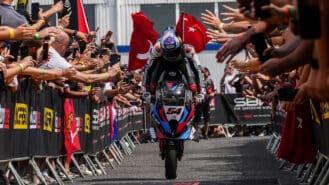Jorge Lorenzo had a perfect weekend in Qatar, his body and motorcycle in winning condition. Not so Casey Stoner…
As a racer, Stoner would appear to have no weak points. He can do things with a motorcycle that strike fear into his rivals and you can’t question his aggression or race strategy.
But his body and his bike do have a few Achilles heels. So far this year he’s already run into problems with his forearms and his back. The Aussie missed the first day of pre-season testing when an old back injury flared up and during the Qatar race he ran into a physical problem that all bike racers dread: arm pump.

Arm pump happens when a rider’s forearm muscles swell during periods of intense activity, which is why it usually occurs during races and not during practice. The swollen muscles constrict nerves and collapse blood vessels, which reduces blood flow and starves the muscles of blood. So the rider’s hands – usually only the right, because it’s busy working the throttle and brake – stops doing what the brain is telling them to do. This can be quite scary at 200mph.

I had it a few times when I was racing, most acutely during the Le Mans 24 Hours in 1988. I’d been off injured for several months and hadn’t been diligent in my training for the big race. During the night the pump got so bad that during braking my hand and fingers would lock into a claw, so I’d arrive at corners unable to release the brake. A few times I’d almost come to a standstill before I managed to open my hand.
Stoner’s arm pump got so bad at Losail that he could hardly keep the throttle open down the straight. He suspected that a new set of gloves might be to blame, but he has suffered arm pump before, at Silverstone in 2010.
Back in the 1980s (when increasing g-forces first made arm pump an issue in bike racing) stricken riders would head straight to their favourite surgeon who would slice open the muscle facia in a (not always successful) effort to cure the problem. These riders would return at the next race, proudly showing off lurid scars down the inside of each forearm.
Stoner is keen to pursue a non-operative fix, but he’s not going to tell us what. “Last time we put in a lot of work to fix it, but not with doctors. Everyone’s got their own theories of what’s the best thing to do. We did things our own way and I don’t want everyone to know my secret for getting rid of it. Last time it worked very well, we fixed it in five days, between Silverstone and Assen.”
So Stoner’s body should be fine for Jerez. But what about his bike? Honda’s new RC213V doesn’t get on very well with the latest Bridgestone slicks, the two combining to create arguably bike racing’s most dreaded technical problem: chatter.

No one has a certain answer to chatter because it’s such a nebulous phenomenon. Some technicians believe it’s a harmonic kickback created by the forces generated as the motorcycle is pushed to the limit through corners. These forces, they say, generate an ultra high-frequency resonance that is too fast for suspension hydraulics to cope with, and is thus transferred to the tyres. Other technicians believe that chatter is the tyre sliding and gripping, sliding and gripping, hundreds or thousands of times through a corner.
Either way, Stoner struggled with chatter at Losail, just as he had struggled with it during pre-season testing. He was already running short of patience during practice and if his crew doesn’t find a proper fix, he will encounter the problem throughout the season, which will seriously damage his title prospects.
This is the always forthright Colin Edwards on the subject of chatter: “Chatter can spoil everything, it’s just a bastard. In the US we call it the jackhammer. In my experience we get chatter every time we go to a rear tyre with a bigger contact patch. In essence the rear has got so much grip that it’s just pushing the front across the track. The front wants to turn, so you start to turn and then the front can’t take it anymore, so the rear takes a little hop to straighten itself out and it just continues at a crazy-fast frequency. Once you get chatter you play with all kinds of crap to get rid of it: weight and stiffness and chassis and suspension.”
Stoner believes that chatter isn’t just a chassis/suspension/tyre problem, he thinks that hi-tech electronics can also be to blame. “The different grip levels from session to session change the way the electronics work which creates the chatter,” he said after practice in Qatar. “It’s difficult to understand how much of it is chassis and how much is electronics.”
Whatever the causes, there’s no doubt that his engineers will be busy working on a fix at this very moment…







